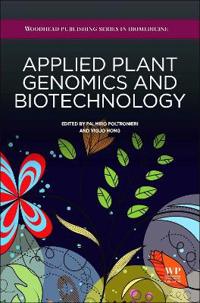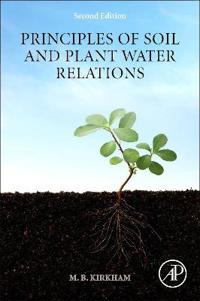Plant Design and Economics for Chemical Engineers (Inbunden)
avMax Stone Peters, Klaus D. Timmerhaus, Ronald E. West
ISBN: 9780072392661 - UTGIVEN: 2002-12-01Laboratory Manual for Stern's Introductory Plant Biology (häftad)
ISBN: 9780077508784 - UTGIVEN: 2013-01Chemical and Process Plant Commissioning Handbook (Inbunden)
avMartin Killcross
ISBN: 9780080971742 - UTGIVEN: 2011-10-01Suitable for engineers in the chemical process and process plant sectors, or for those refreshing their skills in this area, this title provides a guide and reference to preparing a systematic methodology for converting a newly constructed plant, as well as streamlining equipment into an operational[...]
Applied Plant Genomics and Biotechnology
ISBN: 9780081000687 - UTGIVEN: 2015-01Applied plant genomics and biotechnology reviews the recent advancements in the post-genomic era, discussing how different varieties respond to abiotic and biotic stresses, investigating epigenetic modifications and epigenetic memory through analysis of DNA methylation states, applicative uses of RN[...]
Beat Cancer (Häftad)
avJane A. Plant
ISBN: 9780091947958 - UTGIVEN: 2014-06If you or someone you love has been diagnosed with cancer, you want to do everything possible to beat the disease. But with so much conflicting advice and so many options available, how do you decide on the best treatment plan for you? In this major new book, Professor Jane Plant and Professor Musta[...]
Ethylene In Plant Biology (Inbunden)
avFrederick B. Abeles, Page W. Morgan, Mikal E. Saltveit
ISBN: 9780120414512 - UTGIVEN: 1992-07-20Provides a survey of what is known about ethylene, a structurally simplest of all plant growth regulators. This volume contains a bibliographic guide to the literature of this field. It covers progress in molecular biology and biotechnology as well as biochemistry, plant physiology, development, reg[...]
Plant Pathology (Inbunden)
avGeorge N. Agrios
ISBN: 9780120445653 - UTGIVEN: 200501Outlines how to recognize, treat, and prevent plant diseases. This work covers plant diseases such as abiotic, fungal, viral, bacterial, nematode and others. It includes information on molecular techniques and biological control in plant diseases. It also covers the genetics of resistance and manage[...]
Insect Pheromone Biochemistry and Molecular Biology: The Biosynthesis and Detection of Pheromones and Plant Volatiles (Inbunden)
avGary J. Blomquist, Richard Vogt, Brody
ISBN: 9780121071516 - UTGIVEN: 2003-11-20A valuable new reference on insect behavior, this exceptional new text delves into the primary sensory communication system used by most insects -- their sense of smell. This important text covers how insects produce pheromones and how they detect pheromones and plant volatiles. Since insects rely o[...]
Integrative Plant Anatomy (Inbunden)
avWilliam C. Dickison
ISBN: 9780122151705 - UTGIVEN: 2000-04-26Presents the basic concepts and terminology of plant anatomy with a special emphasis on its significance and applications to other disciplines. This book also highlights the important contribution made by studying anatomy to the solutions of a number of problems. It is illustrated with line drawings[...]
Principles Of Plant Disease Management (Inbunden)
avWilliam E. Fry
ISBN: 9780122691805 - UTGIVEN: 1983-01-07Provides a treatment of plant disease management for graduate and undergraduate students in which theoretical and practical elements are combined. This title features a section on epidemiology that includes a chapter in which arthropod vectors (aphids, leafhoppers, whiteflies, Coleoptera and mites) [...]
Dictionary of Plant Lore (Inbunden)
avDonald Watts
ISBN: 9780123740861 - UTGIVEN: 2007-05Knowledge of plant names can give insight into largely forgotten beliefs. For example, the common red poppy is known as 'Blind Man' due to an old superstitious belief that if the poppy were put to the eyes it would cause blindness. Many plant names derived from superstition, folk lore, or primal bel[...]
Physicochemical and Environmental Plant Physiology (Inbunden)
avPark S. Nobel
ISBN: 9780123741431 - UTGIVEN: 2009-06-01Suitable for plant scientists, this title gives a synthesis of modern physicochemical and physiological thinking.[...]
Comparative Plant Virology (Inbunden)
avRoger Hull
ISBN: 9780123741547 - UTGIVEN: 2009-01-27Presents an overview of our knowledge of plant viruses including background information on plant viruses and aspects of virus biology and control. This title draws comparisons with viruses of other kingdoms, animals, fungi and bacteria. It is suitable for students of plant virology, plant pathology,[...]
Plant Cell Biology (Inbunden)
avRandy Wayne
ISBN: 9780123742339 - UTGIVEN: 2009-10-01Covers various aspects of plant cell biology without emphasizing any one plant, organelle, molecule, or technique. This book explains the physiological underpinnings of biological processes to bring original insight related to plants. It includes examples to bring understanding to plant cell develop[...]
Plant Systematics (Inbunden)
avMichael G. Simpson
ISBN: 9780123743800 - UTGIVEN: 201007"Plant Systematics" has made a substantial contribution to plant systematics courses at the upper-undergraduate and first year graduate level. This second edition continues to provide the basis for teaching an introduction to the morphology, evolution, and classification of land plants. A foundation[...]
Plant Biotechnology and Agriculture
ISBN: 9780123814661 - UTGIVEN: 2011-11As the oldest and largest human intervention in nature, the science of agriculture is one of the most intensely studied practices. From manipulation of plant gene structure to the use of plants for bioenergy, biotechnology interventions in plant and agricultural science have been rapidly developing [...]
Plant Biochemistry (Inbunden)
avHans-Walter Heldt, Birgit Piechulla
ISBN: 9780123849861 - UTGIVEN: 2010-11-12Presents the science on the molecular mechanisms of plant life. This book covers the basic principles of plant biology, such as photosynthesis, primary and secondary metabolism, the function of phytohormones, plant genetics, and plant biotechnology. It addresses the various commercial applications o[...]
Chemistry of Plant Phosphorus Compounds (Inbunden)
avArlen W. Frank
ISBN: 9780124071940 - UTGIVEN: 2013-06-07Provides a reference source for scientists engaged in any aspect of plant research - chemistry, biochemistry or physiology. This book focuses on chemistry of phosphorus containing compounds that occur naturally in plant kingdom, and in higher plants. It is comprehensive with respect to nomenclature,[...]
Plant Tissue Culture (Pocket)
avRoberta H. Smith
ISBN: 9780124159204 - UTGIVEN: 2012-08-26Provides a diverse learning experience and is appropriate for both university students and plant scientists. This book offers exercises that demonstrating tobacco leaf infiltration to observe transient expression of proteins and subcellular location of the protein, and information on development of [...]
Principles of Soil and Plant Water Relations
ISBN: 9780124200227 - UTGIVEN: 2014-05Principles of Soil and Plant Water Relations, 2e describes the principles of water relations within soils, followed by the uptake of water and its subsequent movement throughout and from the plant body. This is presented as a progressive series of physical and biological interrelations, even though [...]
Plant Energetics (Inbunden)
avOctavian S. Ksenzhek, O. S. Ksenzhek, Alexander G. Volkov
ISBN: 9780124273504 - UTGIVEN: 1998-02-04Presents the physical and technological aspects of plant energetics. This book covers topics such as interdisciplinary research for a range of investigators, thermodynamics of energy processes in plants, their interconnection and arrangement, and others. It demonstrates the role of electrical and el[...]
Methods in Plant Biochemistry
ISBN: 9780124610170 - UTGIVEN: 1991-09The series, "Methods in Plant Biochemistry", provides an authoritative reference on current techniques in the various fields of plant biochemical research. Each volume in the series will, under the expert guidance of a guest editor, deal with a particular group of plant compounds. Each will describe[...]
Plant Systematics (Inbunden)
avMichael G. Simpson
ISBN: 9780126444605 - UTGIVEN: 2005-01-07Plant systematics is an area central to numerous other biological disciplines. This work contains numerous cladograms that illustrate the evolutionary relationships of major plant groups, with an emphasis on the adaptive significance of major evolutionary novelties. It provides descriptions and clas[...]
Plant Tissue Culture: Techniques and Experiments (Pocket)
avRoberta Smith, James Carne
ISBN: 9780126503425 - UTGIVEN: 2000-02-25Provides laboratory exercises in plant tissue culture that demonstrate major educational concepts. This book covers tissue culture laboratory setup, supplies, media, and explant preparation, and measurements. It includes supplementary sections and scheduling and interrelationships of exercises suita[...]



























